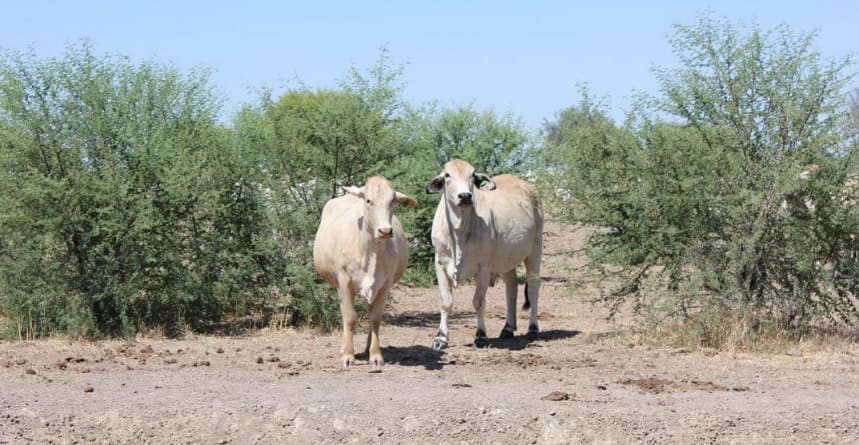
This week’s property review concludes our two-part series looking at the impact that the presence or extent of woody or perennial weeds on a grazing property can have on land value. Click here to view last week’s introductory remarks.
North Queensland based land valuer Roger Hill, a director at Herron Todd White, believes it is up to the market to differentiate land value based on the extent of woody and perennial weed present on a property.
He used the purchase of a motel as an analogy on how values could be impacted.
“Take the due diligence process of acquiring a 20-room motel. Say five of the rooms were in poor condition and couldn’t generate an income. This is just like a cattle property that has moderate to dense infestations of prickly acacia (pictured above) on parts of it, reducing grass yield. Similarly it could be Noogoora Burr infesting a sheep property from upstream in the catchment. In both examples, the ability of the overall asset to generate an income is affected,” he said.

HTW’s Roger Hill
Mr Hill said in order for the motel to achieve a prudent occupancy rate (which is similar to that of a stocking rate) and generate income, these rooms require renovation (risk, effort, time and cost) to bring them up to standard.
“It then takes more time (which is costly) for the occupancy to recover. Would you seek to negotiate a discount in the purchase price to start with? Alternatively, if the 20 rooms were immaculately presented and the motel is already achieving a high occupancy rate (good productivity) would you pay a premium?” he asked.
Given the shock of the invasive weed explosion that has occurred in North Queensland since February flooding and rainfall, Mr Hill said it is up to the property market as it evolves into the next phase to choose to ‘discount for infestations’ or ‘pay a premium for clean country.’
“Perhaps a margin will now appear in the marketplace for a bit of each,” he suggested. “At this stage, there is no market evidence that returns a premium for holistic or regeneratively-managed landscapes, however positive market sentiment is increasing and may well increase profitability and therefore land values.”
In this discussion, it was important to understand market dynamics, as there were other motivators for either the vendor or purchaser at the time of these sales.
Mr Hill said the top-down, macro influence, was the phase of the market cycle on the day.
“If it’s a seller’s market, buyers have less to negotiate with. In this phase, buyers know there will be other people who will pay the price and the result will be in the vendors favour.”
“This is where buyers need to be calculating and not make emotional decisions to acquire a property.”
But the inverse was applicable during the buyers’ market phase, Mr Hill said.
Grass and other factors
As discussed last week, the attraction to grass is also a factor at present. In recent years, there has not been much feed about due to the drought. However, after the monsoonal event this February, there were grass-hungry buyers from drought-affected districts seemingly happy to ignore a prickly acacia infestation on a prospective land purchase.
It also had to be remembered that there were other factors in the negotiation process including access, distance to town/markets, size, land classification, land condition, watering systems and security, fencing and structures.
Mr Hill said he was aware of land managers who now sought to manage their livestock supply chain according to the weed infestation, with cattle or sheep moved from clean country to infested paddocks (but not the other way around). In these circumstances they were seeking to contain the issue, as opposed to seeking to reduce the area.
“Paddocks deemed ‘infested’ are more likely to contain livestock that will be sold off the property (to live export or meatworks).
In the case of property to property transfer, therein lay another biosecurity risk.
“The next buyer needs to know whether the stock were from infested country in the same way as the hay you transport needs to be within your own catchment or from clean country,” Mr Hill said.
Value differentiation
If the market was to differentiate over values, how much per hectare would the difference be?
Mr Hill said it wasn’t prudent to discount on a simple dollar rate per hectare or percentage of value basis, if a property was weed infested – or pay a premium if clean.
“A discount or premium based on a dollar per hectare rate or a percentage of value is simplistic, yet not necessarily commercially prudent.”
He provided an example of how an adjustment (either discount if infested, or premium if clean) could be calculated:
Cost for annual treatment (if infested) or benefit (if clean) = $50,000/annum.
If the opportunity cost of investing that money elsewhere was 7pc in perpetuity, then $50,000 divided by seven percent (0.07) = $714,285.
Mr Hill believes a percentage of turnover (not a dollar rate per hectare) approach allowed for prudent budgeting for all other business operating costs and commitments to be met.
“A percentage of property value (or $/ha approach) may not reflect what the business can afford to spend on the weed issue. Pick the situation where someone does all this hard work, yet cannot pay the fuel bill, wages, the bank or even worse – themselves.”
“The annual in-field, weed treatment of a Burdekin cane farmer I recently spoke to was equivalent to 5pc of his turnover. The maintenance cost of a motel is typically 5-10pc of turnover, and a shopping centre is the same.
“The percentage of turnover budgeting method means all other input costs are adequately considered in the assessing of a budget.”
Preference is to buy clean
Agents spoken to by Beef Central have reported that potential buyers are not really making discounted offers on weed-impacted properties, preferring to buy clean holdings instead.

Tom Brodie
Tom Brodie from Winton-based Brodie Agencies admitted it was difficult to put a figure on discounting solely due to weeds.
“In our region, discounting ranges from 10 to 15pc and even more if the property is badly infested with prickly acacia. Some buyers want to factor weeds into their pricing because it might cost them $25-$50/ha to clean up.”
However, if a property remained on the market because of weeds, Mr Brodie suggested there might be another wave of grass-hungry buyers prepared to overlook the issue.
“For southern sheep operators, it is cheaper to buy feed than to truck them to Queensland. However, cattle producers remain interested because the cost of production is much higher,” he said.
Recent examples
Last year, Mr Brodie sold the 10,423ha backgrounding and fattening block Nargon for $1.75m or $167/ha (bare). At the time it was expected to make around $250/ha.
Located 60km north-east of Muttaburra, a large area of Nargon was heavily infested with prickly acacia, which could have resulted in the slightly lower than expected sale price.
But despite being prickly acacia free, the 16,152ha breeding and fattening Winton property Lilford sold for $4.1m (bare) – well below its $4.5m asking price.
The vendors had controlled any fresh outbreaks of acacia coming in from neighbouring properties, however it is believed the discounting occurred because of the expenditure required on infrastructure and water.
Weed control expenditure
Chris Love is a field scientist with Corteva Agrisciences, covering Queensland and northern New South Wales.
He identified the main problem weeds in western Queensland as prickly acacia and parkinsonian, while closer to the coast it was lantana or giant rat’s tail grass, and in the Burnett, eucalypt regrowth.
“The cost of clearing a moderate weed infestation varies on where the country is, what weeds you’ve got and available resources,” Mr Love said.
“Thick lantana on the coast will cost you $350/ha plus application costs, and landholders must continue to manage the problem. A eucalypt regrowth might cost between $20 and $40/ha depending on what application method you are using. Prickly acacia depends on density and what needs to be achieved.”
While no-one is disputing that weeds are a serious management issue and a real cost to producers, it would seem that the jury is out on whether there is a real impact on sales prices, or whether a range of other market factors ultimately influences sale values.
